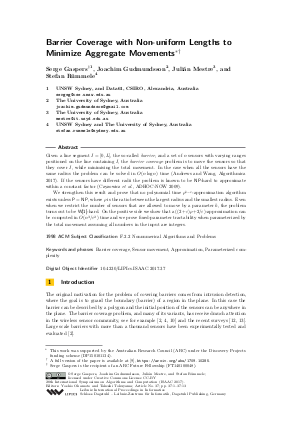Barrier Coverage with Non-uniform Lengths to Minimize Aggregate Movements
Authors Serge Gaspers, Joachim Gudmundsson, Julián Mestre, Stefan Rümmele
-
Part of:
Volume:
28th International Symposium on Algorithms and Computation (ISAAC 2017)
Part of: Series: Leibniz International Proceedings in Informatics (LIPIcs)
Part of: Conference: International Symposium on Algorithms and Computation (ISAAC) - License:
 Creative Commons Attribution 3.0 Unported license
Creative Commons Attribution 3.0 Unported license
- Publication Date: 2017-12-07
File

PDF
LIPIcs.ISAAC.2017.37.pdf
- Filesize: 0.67 MB
- 13 pages
Document Identifiers
Subject Classification
Keywords
- Barrier coverage
- Sensor movement
- Approximation
- Parameterized complexity
Metrics
- Access Statistics
-
Total Accesses (updated on a weekly basis)
0PDF Downloads0Metadata Views
Abstract
Given a line segment I=[0,L], the so-called barrier, and a set of n sensors with varying ranges positioned on the line containing I, the barrier coverage problem is to move the sensors so that they cover I, while minimising the total movement. In the case when all the sensors have the same radius the problem can be solved in O(n log n) time (Andrews and Wang, Algorithmica 2017). If the sensors have different radii the problem is known to be NP-hard to approximate within a constant factor (Czyzowicz et al., ADHOC-NOW 2009).
We strengthen this result and prove that no polynomial time \rho^{1-\epsilon}-approximation algorithm exists unless P=NP, where \rho is the ratio between the largest radius and the smallest radius. Even when we restrict the number of sensors that are allowed to move by a parameter k, the problem turns out to be W[1]-hard. On the positive side we show that a ((2+\epsilon)\rho+2/\epsilon)-approximation can be computed in O(n^3/\epsilon^2) time and we prove fixed-parameter tractability when parameterized by the total movement assuming all numbers in the input are integers.
Cite As Get BibTex
Serge Gaspers, Joachim Gudmundsson, Julián Mestre, and Stefan Rümmele. Barrier Coverage with Non-uniform Lengths to Minimize Aggregate Movements. In 28th International Symposium on Algorithms and Computation (ISAAC 2017). Leibniz International Proceedings in Informatics (LIPIcs), Volume 92, pp. 37:1-37:13, Schloss Dagstuhl – Leibniz-Zentrum für Informatik (2017)
https://doi.org/10.4230/LIPIcs.ISAAC.2017.37
BibTex
@InProceedings{gaspers_et_al:LIPIcs.ISAAC.2017.37,
author = {Gaspers, Serge and Gudmundsson, Joachim and Mestre, Juli\'{a}n and R\"{u}mmele, Stefan},
title = {{Barrier Coverage with Non-uniform Lengths to Minimize Aggregate Movements}},
booktitle = {28th International Symposium on Algorithms and Computation (ISAAC 2017)},
pages = {37:1--37:13},
series = {Leibniz International Proceedings in Informatics (LIPIcs)},
ISBN = {978-3-95977-054-5},
ISSN = {1868-8969},
year = {2017},
volume = {92},
editor = {Okamoto, Yoshio and Tokuyama, Takeshi},
publisher = {Schloss Dagstuhl -- Leibniz-Zentrum f{\"u}r Informatik},
address = {Dagstuhl, Germany},
URL = {https://drops.dagstuhl.de/entities/document/10.4230/LIPIcs.ISAAC.2017.37},
URN = {urn:nbn:de:0030-drops-82591},
doi = {10.4230/LIPIcs.ISAAC.2017.37},
annote = {Keywords: Barrier coverage, Sensor movement, Approximation, Parameterized complexity}
}
Author Details
References
- A. M. Andrews and H. Wang. Minimizing the aggregate movements for interval coverage. Algorithmica, 78(1):47-85, 2017. URL: http://dx.doi.org/10.1007/s00453-016-0153-8.
-
Anish Arora, R. Ramnath, E. Ertin, P. Sinha, S. Bapat, V. Naik, V. Kulathumani, H. Zhang, H. Cao, M. Sridharan, S. Kumar, N. Seddon, C. Anderson, T. Herman, N. Trivedi, C. Zhang, M. Nesterenko, R. Shah, S. S. Kulkarni, M. Aramugam, L. Wang, M. G. Gouda, Y.-R. Choi, D. E. Culler, P. Dutta, C. Sharp, G. Tolle, M. Grimmer, B. Ferriera, and K. Parker. Exscal: Elements of an extreme scale wireless sensor network. In Proceedings of the 11th IEEE International Conference on Embedded and Real-Time Computing Systems and Applications (RTCSA), pages 102-108, 2005.

-
M. Cesati. Perfect code is W[1]-complete. Inform. Process. Lett., 81(3):163-168, 2002.

-
A. Chen, S. Kumar, and T.-H. Lai. Local barrier coverage in wireless sensor networks. IEEE Transactions on Mobile Computing, 9(4):491-504, 2010.

-
D. Z. Chen, Y. Gu, J. Li, and H. Wang. Algorithms on minimizing the maximum sensor movement for barrier coverage of a linear domain. Discrete & Computational Geometry, 50(2):374-408, 2013.

-
J. Czyzowicz, E. Kranakis, D. Krizanc, I. Lambadaris, L. Narayanan, J. Opatrny, L. Stacho, J. Urrutia, and M. Yazdani. On minimizing the sum of sensor movements for barrier coverage of a line segment. In Proceedings of the 9th International Conference Ad-HocMobile and Wireless Networks (ADHOC-NOW), pages 29-42, 2009.

-
S. Dobrev, S. Durocher, M. Eftekhari, K. Georgiou, E. Kranakis, D. Krizanc, L. Narayanan, J. Opatrny, S. Shende, and J. Urrutia. Complexity of barrier coverage with relocatable sensors in the plane. Theoretical Computer Science, 579:64 - 73, 2015.

-
R. G. Downey and M. R. Fellows. Fixed-parameter tractability and completeness II: on completeness for W[1]. Theoretical Computer Science, 141(1&2):109-131, 1995.

-
S. Gaspers, J. Gudmundsson, J. Mestre, and S. Rümmele. Barrier coverage with non-uniform lengths to minimize aggregate movements. CoRR, abs/1709.10285, 2017.

-
S. Kumar, T.-H. Lai, and A. Arora. Barrier coverage with wireless sensors. In Proc. of the 11th International Conference on Mobile Computing and Networking, pages 284-298, 2005.

-
M. Mehrandish, L. Narayanan, and J. Opatrny. Minimizing the number of sensors moved on line barriers. In IEEE Wireless Communications and Networking Conference, pages 653-658, 2011.

-
D. Tao and T. Y. Wu. A survey on barrier coverage problem in directional sensor networks. IEEE Sensors Journal, 15(2):876-885, 2015.

-
F. Wu, Y. Gui, Z. Wang, X. Gao, and G. Chen. A survey on barrier coverage with sensors. Frontiers of Computer Science, 10(6):968-984, 2016.

